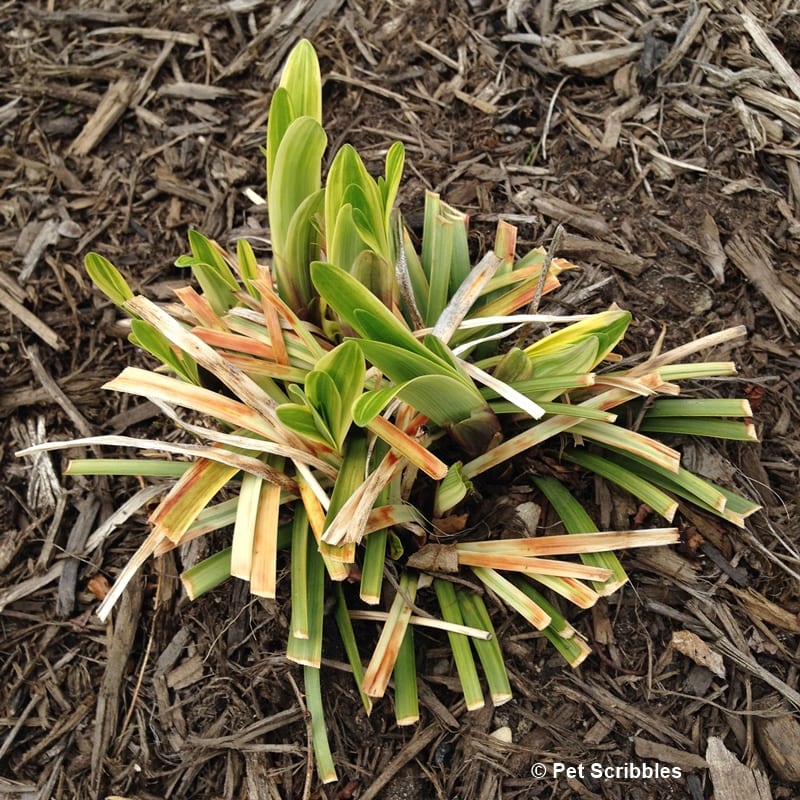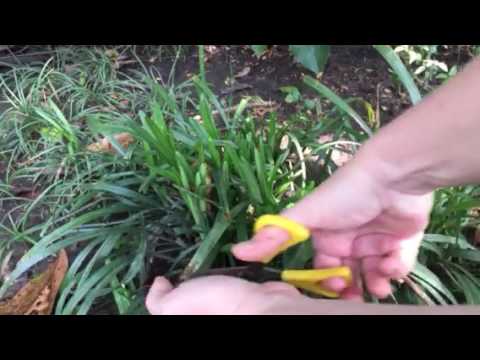To prune liriope, cut back the foliage in early spring before new growth begins. Pruning promotes new growth and helps maintain a neat appearance.
Liriope, also known as monkey grass or lilyturf, is a popular ornamental grass-like plant known for its low maintenance and resilience. Pruning is an essential part of caring for liriope, as it helps rejuvenate the plant and control its size.
By following the proper pruning techniques, you can ensure your liriope remains healthy and attractive year after year. We will explore the steps to prune liriope effectively and provide some helpful tips along the way. Whether you are a seasoned gardener or a beginner, this guide will assist you in achieving optimal results with your liriope pruning endeavors.

Credit: www.petscribbles.com
The Benefits Of Pruning Liriope
Pruning Liriope offers several benefits for your garden. It enhances the overall appearance by maintaining its neat and tidy look. By removing dead or damaged leaves, you promote healthier growth and prevent the spread of disease. Pruning also encourages blooming and prolongs the flowering season of your Liriope plants.
Trimming the foliage allows more sunlight to reach the plant, stimulating better flower production. Regular pruning also prevents overcrowding and ensures that your Liriope plants continue to thrive. So, make sure to include pruning as a part of your garden maintenance routine to enjoy the many advantages it brings.
How to Prune Liriope: Step by Step Guide
Assessing The Need To Prune Liriope
Assess whether your Liriope needs pruning by checking for overgrown or damaged foliage. Consider the impact on surrounding plants and landscapes before making any cuts. Remember that different varieties of Liriope have specific pruning requirements, so understanding them is crucial.
By evaluating these factors, you can ensure a successful pruning process for your Liriope plants.
Essential Tools For Pruning Liriope
Pruning liriope requires essential tools for effective results. Secateurs or pruning shears are necessary for precise cuts. Gardening gloves are important to protect your hands. A pruning saw is required for larger sections or tough stems that need to be removed.
To prevent the spread of disease, it is crucial to use a sterilizing solution on the tools. By following these guidelines, you can ensure the health and beauty of your liriope plants. So, gather your tools and start pruning your liriope with confidence! It is a simple yet important task that will keep your liriope looking neat and well-maintained throughout the year.
Happy pruning!
Best Time To Prune Liriope
Pruning Liriope is a crucial gardening task that should be timed appropriately for optimal results. In considering seasonal variations and the specific needs of Liriope, it is vital to determine the best time for pruning. One ideal time for this task is in the spring, as it allows for maximum regrowth and rejuvenation.
By pruning during this season, you ensure that the Liriope has ample time to recover and flourish. Alternatively, another important consideration is winter pruning. It is essential to time this carefully to avoid potential frost damage. By strategically trimming Liriope during the winter months, you minimize the risk of harming the plant and allow it to endure the colder weather successfully.
Plan your pruning activities accordingly to maintain the health and vibrancy of your Liriope.
Guide To Pruning Liriope
Pruning liriope is essential for its growth and overall appearance. Start by clearing the area around the plants, ensuring they have enough space to flourish. Remove any dead or damaged leaves and stems, as they can hinder the plant’s health.
If the foliage and grassy blooms become overgrown, cut them back to maintain a neat and tidy look. It’s important to shape the liriope gently, ensuring it maintains a natural and balanced appearance. Lastly, clean up the pruned materials and dispose of them properly.
Following these steps will help your liriope thrive and add beauty to your garden.
Avoiding Common Mistakes
When pruning Liriope, it is crucial to avoid over-pruning and jeopardizing the plant’s health. It’s also important not to neglect sanitizing your pruning tools. Timing is key as cutting too late or too early in the flowering cycle can have negative effects.
Proper pruning practices will promote healthy growth and enhance the overall appearance of your Liriope. Remember to assess the plant’s needs and remove any dead or damaged foliage. Trim back the outer edges to maintain a neat and tidy appearance.
Be mindful of the plant’s size and shape, and aim to maintain a balanced growth pattern. By following these guidelines, you can ensure that your Liriope remains healthy and vibrant throughout the year.
Tips For Maintaining Pruned Liriope
Pruning liriope is essential for maintaining its health and appearance. After pruning, it’s important to mulch and water the surrounding area. Removing debris and fallen leaves regularly helps keep the plant tidy. Monitoring the liriope for signs of new growth is crucial in adjusting your pruning techniques.
Observe the overall health of the plant and make any necessary adjustments to ensure it thrives. Remember to keep your sentences concise and avoid using repetitive terms to maintain reader engagement. With proper maintenance, your pruned liriope will continue to flourish and beautify your garden.
Frequently Asked Questions For How To Prune Liriope
What Time Of Year Do You Cut Back Liriope?
Liriope is typically cut back during late winter or early spring.
What To Do With Overgrown Liriope?
Trim overgrown liriope by cutting it back to about 6 inches tall. Avoid cutting it too short to allow regrowth.
When And How To Cut Back Monkey Grass?
Monkey grass should be cut back in early spring before new growth appears. Use clean, sharp garden shears to remove old foliage close to the ground.
What Causes Brown Tips On Liriope?
Liriope can develop brown tips due to overwatering, underwatering, nutrient deficiencies, or fungal diseases.
Conclusion
Overall, pruning liriope can be a beneficial practice to maintain the health and appearance of these popular garden plants. By following the proper techniques and timing, you can help your liriope plants thrive and add beauty to your landscape. Regularly removing old growth, dividing crowded clumps, and shaping the plants can encourage new growth and prevent them from becoming overgrown.
Remember to use sharp and clean tools, and always sanitize them to avoid spreading diseases. Pruning in the early spring or early fall is recommended, as it gives the plants enough time to recover before extreme temperatures. While there may be some slight variations in pruning methods depending on the specific liriope species, the general guidelines discussed should be applicable to most varieties.
By investing a little time and effort into proper pruning techniques, you can ensure that your liriope plants will continue to flourish for years to come.

